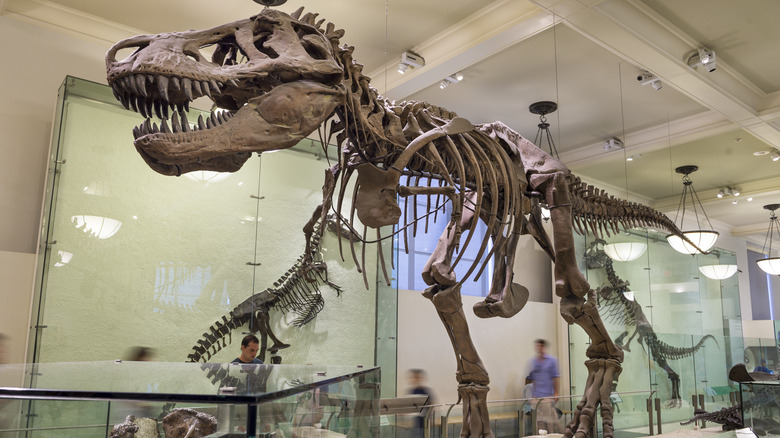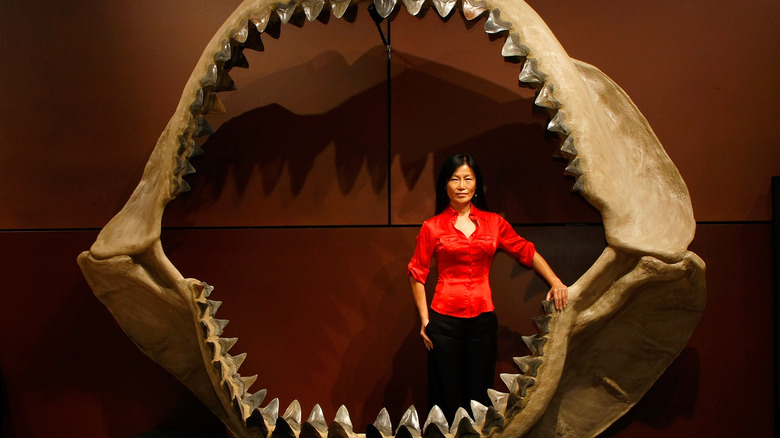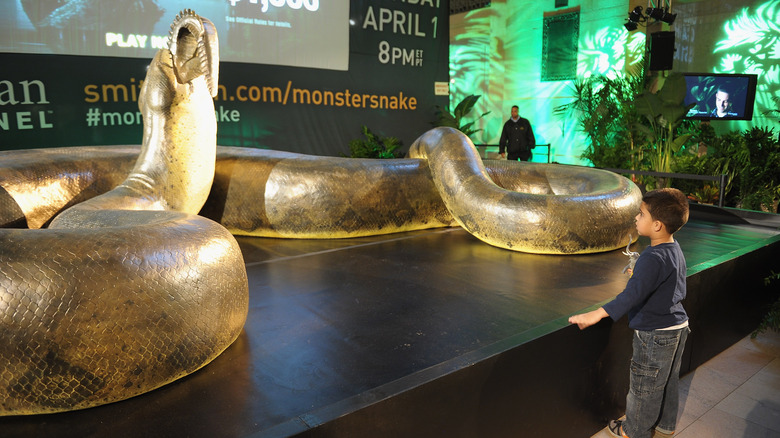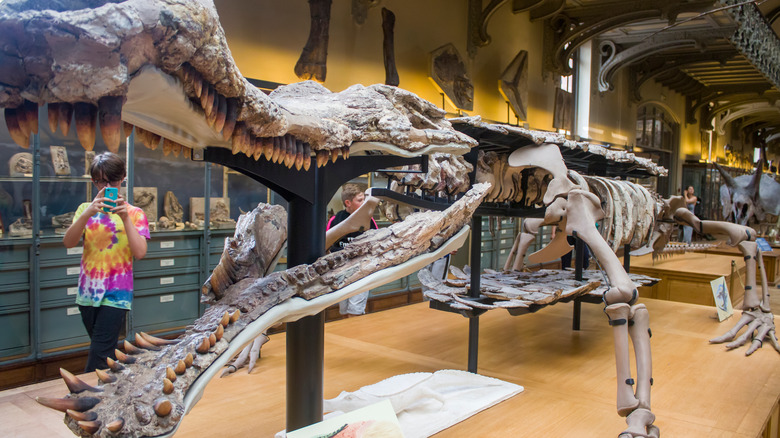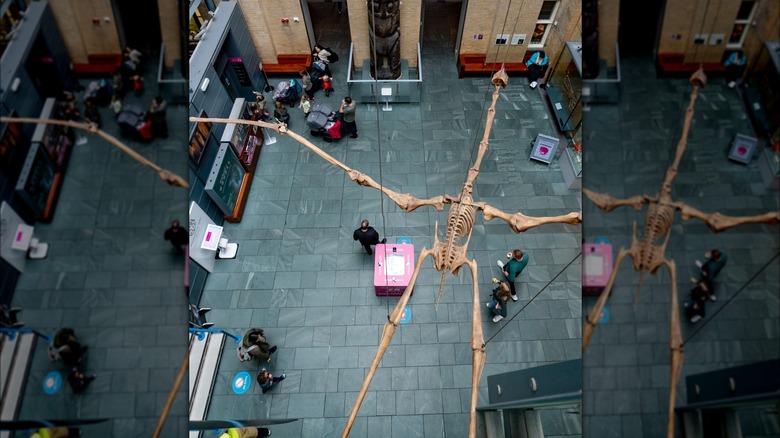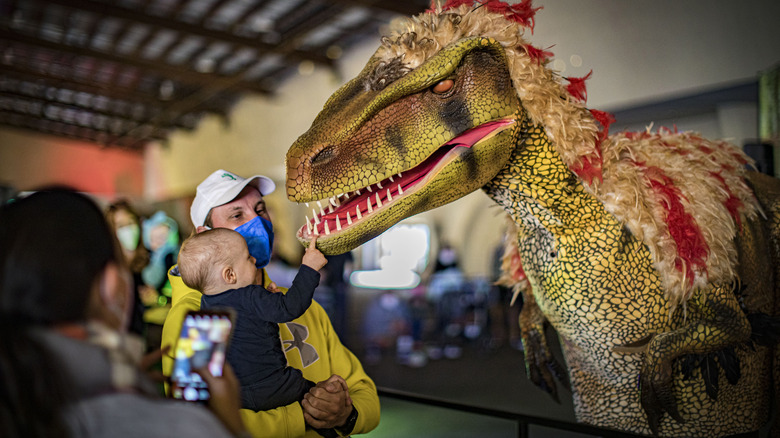5 Deadly Prehistoric Animals We're Lucky Went Extinct
So humans, right? We've got decently-sized brains locked in bone prisons, generally walk on two legs unless drunk, have bad eyesight, suffer from the existential horrors of consciousness, and complain when we have a hangnail. In other words, we're pretty pathetic in comparison to many other animals. How in the heck did our ancestors survive? Truthfully: cooperation and inventive tool-making, longevity while tracking prey over long distances, and a whole lot of sex to produce enough offspring to offset a hunter-gatherer mortality rate of 49% before age 15. But one-on-one versus a bear, tiger, orca, or even, say, a very angry mongoose? We're done.
That being said, animals like modern-day bears, tigers, orcas, etc., are themselves pathetic in comparison to some species that have gone extinct. Let's just be glad there are no Tyrannosaurus rexes hanging around ala the lessons of human hubris imparted via the "Jurassic Park" franchise. Such species terrorized the prey of their time, were hunted by few, and died only because of climatological changes. But a dinosaur like the Tyrannosaurus rex is just the most well-known, even passé choice when envisioning the running, swimming, and flying monstrosities of Earth's past.
As the British Geological Survey shows, Earth has passed through countless geological phases over hundreds of millions of years, from the Cambrian period 541 million years ago to the current, human-dominated Holocene Epoch. Landmasses, plant life, and animal life evolved the entire time and produced menaces perfectly suited to decimate fellow creatures of their time, let alone soft, fleshy humans.
Megalodons could eat you and not even notice
Megalodons, "hyper apex predators," sit at the top of any list of creatures we're glad are extinct. When envisioning a megalodon, think "Jaws" but big enough to fit an elephant inside — or five to six surfers. Think we're kidding? Great white sharks reach up to 21 feet in length, while megalodons could reach almost 59 feet long. Sure, that's still much smaller than a modern-day, 110-foot-long blue whale — the largest animal that's ever existed on Earth. But their teeth were already bigger than your hand (they were up to 7 inches long), so anything bigger would have been overkill. "Megalodon," in fact, means "large tooth."
Otodus megalodon — by the Latin taxonomy — date back to about 20 million years ago and prowled the oceans for a full 13 million years. Assumedly, they terrorized anything smaller than them, including ocean life as big as humpback whales. As The Natural History Museum at South Kensington explains, megalodons were marauding death machines sporting a double row of 276 serrated teeth digging in at a bite force of up to 182,201 Newtons, or about 41,000 pounds of pressure. To put that in perspective, hippopotamuses have the strongest bite force of any animal alive today, and their bite force is 8,130 Newtons per square inch. And yes, megalodon teeth make great white shark teeth look like oversized guitar picks. But despite all comparisons to modern-day great whites, megalodons had longer snouts and a flatter build — they looked more like modern-day blue sharks. Not that you'd notice if it bit you in half.
Titanoboas could crush and consume a human
Because ancient, extinct, and deadly animals often take the form of "modern animal, but bigger," we might as well talk about the Titanoboa next. As the name says, Titanoboas were similar to modern-day boa constrictors: Big, thick snakes that wrapped around their prey, strangled them, and swallowed them whole. Modern boas can reach up to 13 feet long, weigh 100 pounds, and eat smallish animals like opossums, mongooses, rats, birds, etc. But as the word "titan" in Titanoboa implies, they reached nearly 43 feet long and weighed up to 1.25 tons. Such a horror would have approximately 0% difficulty wrapping up a human and crunching its bones.
Titanoboa cerrejonensis fossils were first classified in 2009 when researchers found 30 of their skeletons in modern-day Colombia. The fossils dated back to 58 to 60 million years ago within the Paleocene Epoch, aka the geological period of time directly following the extinction of the dinosaurs. This is when Earth's plants and animals started taking on shades of the present, when mammals diverged into numerous varieties and dense forests started to arise across the planet. And yes, Titanoboa cerrejonensisis is the largest snake species that ever existed — that we know of.
As for the question of how Titanoboas got so big, Smithsonian Magazine says the answer is heat. The Paleocene Epoch was hotter and wetter than today, which encouraged the growth of plants and cold-blooded species like snakes. Thank goodness the planet isn't warming or anything.
Sarcosuchus was the largest crocodile to ever live
For our next entry let's do something wildly different. Just kidding — we've got another "modern animal, but bigger" entry in the form of one of the largest crocodiles that ever lived: Sarcosuchus, aka Sarcosuchus imperator by the taxonomic name. That very imposing, super-cool word "imperator" was a title for Roman emperors that meant "commander." And while Sarcosuchus might not earn the title "Commander of the Reptiles," Animalogic at least says that they "ate dinosaurs for breakfast" — literally.
Sarcosuchus lived about 110 million years ago at the transition from the Early Cretaceous Epoch to the Late Cretaceous Epoch, smack dab in the middle of dinosaur land. As the Natural Museum of History at South Kensington says, this was a time before flowering plants, when there was no ice on the poles and mammals were limited to little furry critters scurrying around underfoot. Extinct Animals explains that Sarcosuchus did much of what modern-day crocodiles do: Hunkered down near water and lashed out at prey when they strolled by for a drink. If the prey was slow enough, Sarcosuchus might follow. If something spooked Sarcosuchus, it would flee into the water.
Sarcosuchus reached up to 40 feet in length, weighed nearly 9 tons, and had a strangely large snout and overbite that left a gap between its jaws when its mouth was shut. That jaw, by the way, was 6 feet long — the perfect length for consuming Floridians. And yes, Sarcosuchus did target dinosaurs of the smaller variety, even other crocodilians.
Quetzalcoatlus terrorized the skies
So you know how some folks freak out if a seagull or pigeon whizzes by their head? Those birds could poop on you, maybe poke your eye, steal your sandwich, etc. But how about a bird with a bill so long that it could skewer you like a piece of meat on a kebab? We're talking about Quetzalcoatlus northropi, one of the biggest pterosaurs — flying reptiles — that ever lived. It existed earlier than the other animals in this article during the Late Jurassic Epoch from 161 to 146 million years ago.
Quetzalcoatlus wasn't a bird as you might imagine, nor is it related to modern birds. It had no tail, hair instead of feathers, a neck than comprised more than half of its height (10 out of 16 feet), weighed 550 pounds, had a 20-foot-wide wingspan, could fly up to 80 miles per hour, and had a super long, slender beak like the blade of a rapier. If this sounds like absolute nightmare fuel, then you'll be horrified to know that it used its beak like chopsticks, as UC Berkeley News quotes Wann Langston, curator of UT Austin's Vertebrate Paleontology Laboratory. We're talking swooping down from the skies, snapping up suitably sized prey like lizards and small mammals, kicking its head back, and guzzling a squirming animal whole like a modern heron does fish. We know that it ate like this because it didn't have any teeth, which is good because it would be ultra-freaky if it did.
Raptors would have made the ideal human hunters
We're going to end this article not with the giant Tyrannosaurus rex, but its smaller predatory cousin, the raptor. We've been leaning hard into the "bigger, scarier" motif in this article, but that isn't always the case. In fact, when thinking of predators ideally suited to chowing down on human life, raptors might top the list. That's because they're smaller, faster, leaner, capable of squeezing into spaces that would bar larger creatures, and — as paleontologist Cassius Morrison says on Business Insider — might have even climbed trees. Funny enough, the closest modern comparison to raptors may be ostriches, which can disembowel a person with a single kick — just like raptors could with their foot claws.
"Raptor," in fact, is a catch-all term for numerous species of a particular variety of feathered reptile. Some were as small as a chicken and might gnaw your leg off, while others weighed 500 pounds and might tear apart your head. They survived all the way from 145 to 65 million years ago and only died off when the asteroid Chicxulub struck Earth. The rocky celestial body killed off the dinosaurs and put an end to all of this megafaunal nonsense by paving the way for apes like us, bereft of natural defenses. We're sad to report, however, that velociraptors — featured in "Jurassic Park" — were actually chicken-sized and probably kind of dumb. Not that it would matter much if one of them lunged at your throat.
